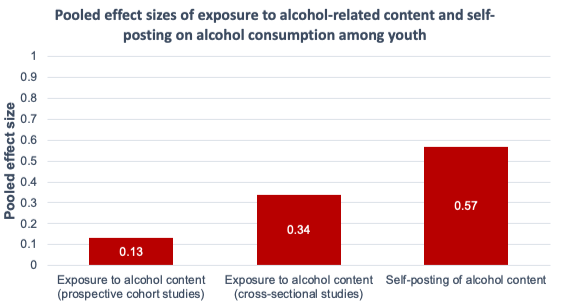The DRAM, Vol. 20(4) – The relationship between youth drinking and social media engagement
Alcohol is a significant risk factor of disease throughout the world. Alcohol use is especially dangerous for young people because it can alter their brain development. A growing body of scientific research suggests that exposure to social media content that includes information related to alcohol consumption can influence the likelihood that youth develop favorable attitudes toward alcohol and begin drinking sooner. This is because social media can cultivate normative expectancies creating the impression that “everyone does it.” This week, The DRAM reviews a study by Brandon Cheng and colleagues that synthesized the previous studies examining the relationship between social media content related to promoting alcohol consumption, self-posting about alcohol content, and youth drinking.
What was the research question?
Is there an association between exposure to alcohol-related content on social media, self-posting about alcohol, and alcohol consumption?
What did the researchers do?
The researchers conducted a pre-registered systematic review and meta-analysis. Their study included studies that examined associations between exposure to alcohol-related content on social media, self-posting about alcohol on social media, and youth drinking. To acquire their sample the researchers searched four academic databases, which resulted in 33,215 potential studies. They then inspected each study for its relevance in inclusion in the systematic review and meta-analysis. A total of 30 studies met all of their inclusion criteria.1 The researchers extracted details from each study. They assessed studies that employed similar designs and included similar outcomes via a random-effects meta-analysis. The researchers also conducted narrative analyses on studies that had incompatible methodologies, but examined the same outcomes.
What did they find?
Based on the cross-sectional studies, greater exposure and self-posting of alcohol-related content were both associated with greater alcohol consumption. The researchers also meta-analyzed three prospective cohort studies that found greater exposure to alcohol content predicted greater future alcohol consumption. Results from narrative analyses indicated that overall, exposure to alcohol-related content and self-posting alcohol content were each positively associated with greater average alcohol consumption. See Figure for all meta-analytic results.

Figure. Pooled effect sizes for the effect of exposure to alcohol-related content on social media and for self-posting alcohol-related content on alcohol consumption. Click image to enlarge.
Why do these findings matter?
These results suggest that social media can have a strong influence on young peoples’ drinking habits. As a result, we need systematic efforts to promote media literacy among young people. Media literacy is the ability to critically interpret and respond to media content (including social media), considering the context and motivations behind that content. Those who are media literate can make informed decisions and protect themselves from potentially harmful influences. By educating youth in this area, it might be possible to limit their susceptibility to alcohol-related social media content. These results also suggest that social media companies are not doing enough to regulate the amount of alcohol-related content that youth on their platforms consume. Government and regulatory agencies have long recognized the importance of restricting alcohol-related content on children’s television programs. However, no such regulations exist for social media companies.
Every study has limitations. What are the limitations in this study?
This study was limited by the fact that many of its included studies used self-report measures of social media use and alcohol consumption. This is a limitation because some things might be difficult to accurately remember (i.e., how much social media does one use, what do they see on social media) or subject to social desirability biases (i.e., how much alcohol does one consume) that could affect how accurately people report information. Future studies should use measures that are not susceptible to these issues (such as physiological data). Another limitation was that many of the studies that were included in this study were from Western, industrialized countries. This limits the study’s ability to draw conclusions about youth living in other regions of the world are affected by alcohol-related content on social media.
For more information:
The National Institute on Alcohol Abuse and Alcoholism has tips and resources for people struggling with problem drinking. For additional drinking self-help tools, please visit our Addiction Resources page.
— Seth McCullock, PhD
What do you think? Please use the comment link below to provide feedback on this article.
________________
1. The researchers only included studies that met each of the following criteria: (1) measured exposure to alcohol-related media or social media content; (2) measured alcohol consumption; (3) were focused on a sample of youth or young adults; and (4) were published in English. In addition, the researchers were only interested in studies that used a cross-sectional design, specifically examined alcohol-related content on social media, were focused on those aged 24-years old or less, and reported alcohol use as an outcome.